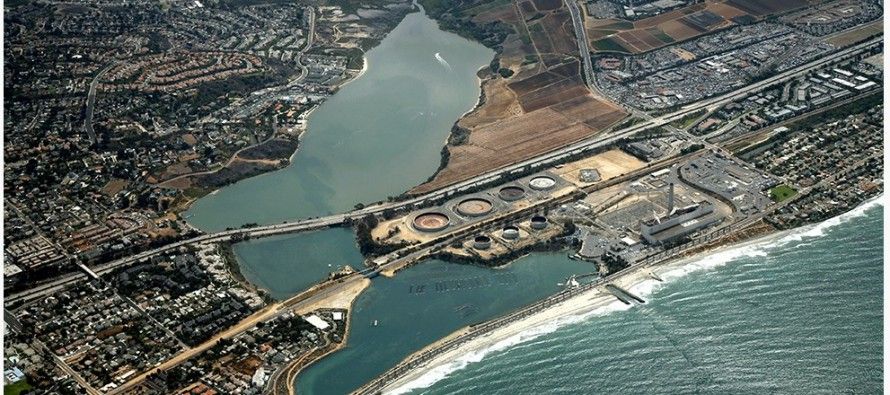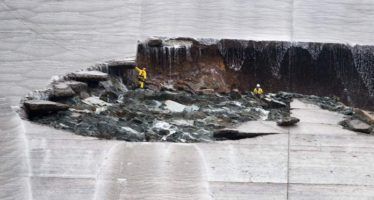Largest U.S. desalination plant nears CA open

 California has begun its biggest foray into desalination.
California has begun its biggest foray into desalination.
Located in Carlsbad, in the San Diego area, the plant has raised hopes for drought relief — but has brought elevated stakes along with it. “The billion-dollar project is only the nation’s second major seawater plant,” noted the Associated Press. “The first U.S. foray in Tampa Bay is widely considered a flop.” That plant, a decade in the making, lost financing and couldn’t pass performance tests, the AP added. Its capacity was only half that of the Carlsbad plant, expected to churn out 50 million gallons of drinking water every day.
To avoid a Tampa-style debacle, the San Diego County Water Authority brought in Poseidon Resources, a premier developer that agreed to shoulder some financial risk in exchange for a sizable investment return, including performance-based incentives. But Poseidon’s labors have so far come at a substantial cost. The plant “will cost $1 billion to construct over the course of the next few years and operational costs will remain high due to its energy consumption,” wrote Morgan Stanley advisor Larry Palmer in the San Gabriel Valley Tribune.
“Indeed, despite fears that Wall Street is making money off the drought, so far it has mainly been Poseidon’s investors who have been on the losing end,” the New York Times recently said of Poseidon. “The company’s first return on its investment is not expected until next year, after years on the drawing board.”
Beach backlash
And Poseidon has already faced major obstacles to building on its success in Carlsbad. For over a decade, the company has labored to secure permission to construct a plant in Huntington Beach, where surfers, beachgoers and environmentalists have pushed hard to fend off desalination. “After nine hours’ worth of public comments, many of which came from supporters of environmental groups Surfrider Foundation and Orange County Coastkeeper, and facing an obviously un-winnable vote, Poseidon withdrew its coastal development permit application” in November 2013, as the OC Weekly noted.
Clashes have repeatedly broken out around the significant alterations to marine life that the Huntington Beach plant would impose. But the debate over the right approach has been mired in uncertainty. It’s “unclear which method of bringing in seawater — open-ocean through an existing pipe or subsurface intake — is actually more environmentally friendly,” the Orange County Register recently observed.
While a “subsurface intake would assuredly kill fewer fish and fish larvae that otherwise would get sucked into an open ocean pipe, even if the pipe had screens,” building the intake “would last five to seven years, depending on the construction method, and disturb 25 acres of ocean floor habitat. Plus, the subsurface intake would have to be cleaned — sand and sediment scraped off — every few years, re-disturbing the habitat for decades after construction was done,” the paper added.
Innovating desalination
Although the biggest industry players have made the biggest headlines in desalination, several startups have also sought to make headway. Manoj Bhargava, famous for his 5-Hour Energy drink, has hatched plans to sell California cities “a desalination unit roughly the size of a flatbed truck that relies on a conventional power source to distill seawater into freshwater well beyond Environmental Protection Agency guidelines,” as Fortune reported.
“A single Rain Maker can be placed in a town with a wastewater plant. In a crisis, hundreds could be stacked on an ocean barge to process seawater. Coastal desalination facilities typically cost billions to construct and require massive amounts of energy. […] Regulators at the Brackish Groundwater National Desalination Research Facility, a testing facility administered in New Mexico by the Department of the Interior, have given it a stamp of approval.”
California startup WaterFX, meanwhile, has begun crowdfunding $10 million of the cost of its new solar-powered desalination plant, which “will likely reach the construction phase early next year in Fresno County and will make enough water to be used across 2,000 acres of cropland a year, or to run through 10,000 homes,” according to Edie.net. “WaterFX’s design will run fully on solar power, helping minimise the plant’s carbon footprint. The plant removes the salt from the water and turns it into usable products, unlike traditional desalination, which dumps salt and brine back into the sea, which can hurt ecosystems.”
Related Articles
Wells Fargo punishment spreads from CA
In the wake of California’s unprecedented punishment of San Francisco-based Wells Fargo for bogus lending practices, legal sanctions spread eastward,
Prop. 13 Circuit Breaker Halts Tax Losses
JULY 8, 2011 By WAYNE LUSVARDI AND CHARLES B. WARREN California’s Proposition 13 is working to halt a larger and
California seeks fourth federal disaster declaration
Still reeling from a wild weather season, California chalked up a fourth request for federal disaster aid, as Gov.




